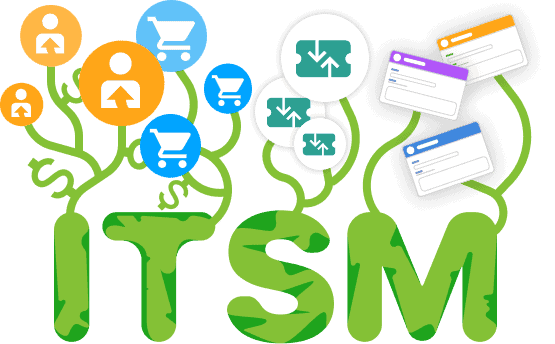What is IT Service Management (ITSM)?
ITSM, short for IT Service Management, is a collection of processes and policies that enable organizations to design, implement, manage, and improve IT services offered to customers.
What is IT Service Management?
IT services include automation systems, applications, and analysis tools needed to operate the day-to-day activities of your business. But how do these services operate with enough efficiency to create value for your company? This is where ITSM comes in.
There are two main principles of ITSM:
- Service is the main form of value provided by IT.
- The best approach to organizing IT services is to establish these processes with clearly defined goals, objectives, and roles and responsibilities.
Organizations with an ITSM strategy aim at delivering quality services to internal stakeholders, IT administrators, and customers because it drives company growth. Effective management of your IT services will lead to happier employees and satisfied customers! Through ITSM, organizations can also improve their business performance by optimizing how these processes are carried out.
Why your business needs IT Service Management (ITSM)
The departments of your organization each function to provide a service, whether it be internally or externally. These services could include providing technical assistance, account management, organizational changes, human resources, and budgeting. How these services are used by your employees can have a profound effect on how your business operates. A strong ITSM process can increase the productivity and overall happiness of your employees by maintaining a focus on the resources they need to do their job better.
What are the benefits of IT Service Management (ITSM)
An efficient IT service management strategy gives employees the flexibility and confidence they need to complete tasks knowing that the resources they require are within arm’s reach. The main benefits of an ITSM solution include:
Reduce your IT costs
Save money with effective problem management and knowledge management processes that resolve recurring issues, speed up resolution times, and increase employee productivity.
Improve your service quality
Create a custom workflow that removes the need for manual operations and promotes cooperation among your teams to achieve success.
Communicate seamlessly
Streamline the way your users communicate by replacing long and inconsistent email chains with processes that ensure the right people get connected with the right resources.
Reduce wasted resources
You could also save your employees’ time and effort by preventing duplication of work, guaranteeing more efficient processes, and minimizing unnecessary expenses.
Increase business efficiency
Reduce downtime, prevent serious issues before they occur and remain compliant to risk management requirements both internally and externally.
Start your trial with Alloy Software today
Core ITSM processes
Organizations that want to run more smoothly must provide high-quality services to their employees in order to maximize their productivity and effectiveness. The processes of ITSM, when applied appropriately, have the potential to accomplish precisely that.
Incident Management
The main goal of the incident management process is to restore disrupted IT services for your users after an unplanned interruption via an end-user incident ticket.
Problem Management
Address the underlying causes of multiple incidents, minimize the impact of IT service interruptions, and create solutions or workarounds.
Change Management
The systematic strategy associated with the transition or modification of organizational procedures or technologies is known as change management. Effective Change Management enables organizations to make improvements to their information technology infrastructure and applications with the least amount of disruption to their operations.
Service Catalog Management
When you use the Service Catalog, you can standardize your service request and fulfillment procedures, which allows you to measure and enhance the overall assistance you are providing to your business.
Service fulfillment
In the business world, order fulfillment is the process of obtaining orders and then processing and delivering them to users. A consumer places an order online, and the purchase is delivered to the customer. This process is crucial in ensuring that customers have a positive customer experience. With IT services, the IT team considers the employees as the buyers placing orders online. And seamless service fulfillment improves employees’ experiences in this organization.
A vital component of a successful service fulfillment process is the self-service portal. With the help of a self-service portal, users are able to request services, software, hardware, and network resources in a smart and simple manner without having to think about it. Service fulfillment is part of the request management discipline.
Configuration Management
Control, monitor, and document the configuration of your IT assets that deliver services and provide value to your company. IT Asset Management and Configuration Management are closely connected disciplines.
Service Level Management
Ensure that your current and planned IT services are designed to fit the specific needs of your customers.
ITSM processes in ITIL
ITIL, the most universally accepted approach to ITSM, is a framework of best practices and recommendations that organizations refer to when managing IT operations and services. ITIL is often used to go through potential changes or a high-growth stage of a business while also ensuring that your ITSM strategy is running smoothly and efficiently.
The difference between ITIL and ITSM might be puzzling. Our article on this topic explains it in detail.
The ITIL framework consists of five different areas that collectively compose an organization’s “service lifecycle.” These ITSM best practices help to improve the quality of service delivery and how an organization’s IT processes function.
Service Strategy
This includes defining the pool of IT services to meet the business needs through planning a strategy, managing a service catalog, financial compliance, anticipating demand, and identifying user needs.
Service Transition
Building and testing the designed services to ensure that they work smoothly and do not interfere with the delivery of other existing services, especially when these services are being updated or changed.
Service Transition
Building and testing the designed services to ensure that they work smoothly and do not interfere with the delivery of other existing services, especially when these services are being updated or changed.
Continual Service Improvement
Maintaining an emphasis on continual improvement is possible by adjusting your activities according to the changing needs of the business. Keeping track of predetermined KPIs plays a significant role in identifying areas for improvement.
ITSM vs. ITIL
To fully leverage the processes of ITSM and the ITIL framework, we must be able to understand the difference. ITIL is the most commonly used framework for ITSM, but it’s not the only framework that organizations may use. They may be employing ITSM, but they may also be using one of the following standards:
- COBIT – A framework relating to the governance of enterprise IT
- ISO 20000 – An international standard for IT Service Management
- MOR – The Microsoft Operations Framework consists of a series of guides for creating, implementing and managing quality IT services.
- USMBOK – The Universal Service Management Body of Knowledge works as a “companion” to support existing ITSM resources such as ITIL in terms of both strategy and operations.
- ITIL
Some organizations use a combination of frameworks or standards, such as ITIL plus COBIT.
Start your trial with Alloy Software today
























